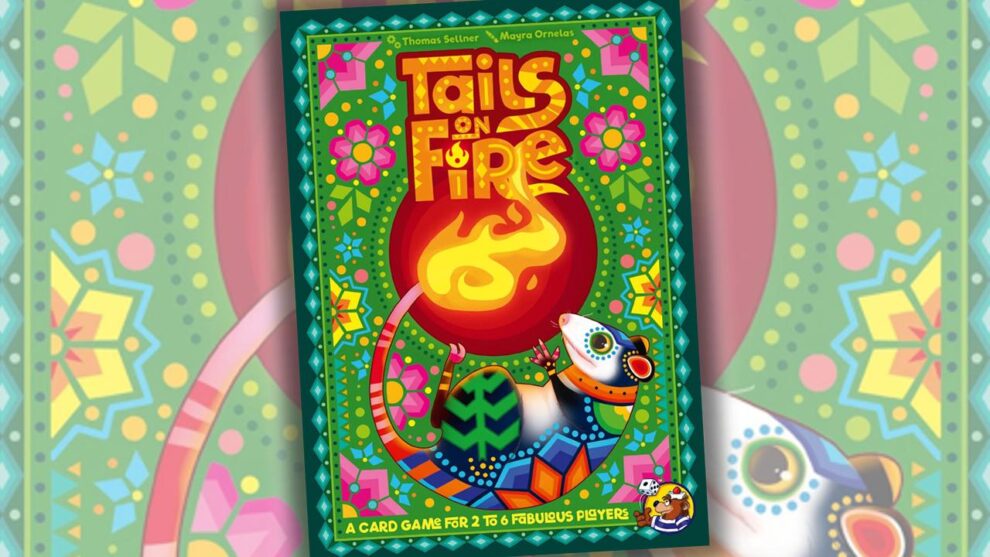Disclosure: Meeple Mountain received a free copy of this product in exchange for an honest, unbiased review. This review is not intended to be an endorsement.
“So, what’s the strategy here?”
I was talking to my eight-year-old friend Theodore about the card game in front of us, Tails on Fire (2022, HeidelBÄR Games). We watched the short rules video together, then looked around wondering how to best navigate the game’s intentions.
“I don’t know,” I responded, to Theodore’s earlier question. “I know we have to pick three cards, but honestly I think sometimes luck has more to do with the choices here than strategy.”
Theo and I gave Tails on Fire our best effort in the two-player format, then I expanded to a three-player game with my family then a six-player game with a mix of family and friends. One thing remained consistent throughout my games of Tails on Fire—the card art, by Mexican artist Mayra Guadalupe Ornelas Ramos, is the star of the show no matter how many players you get to the table. Mayra’s pictures of possums in various settings are glorious and will occasionally make you want to stare at the cards only for the images.
The game? Meh, it’s OK.

Pick Three
Tails on Fire is a nine-round card game where rounds are won by the last player to play to the discard pile in the center of the table. From a hand that begins with every player holding the same 10 cards (numbered 1-9 and a single “+1” card), players have to choose three cards that will be available for the active round.
Using a small deck of “Fire” cards, rounds begin with a player playing a card number matching the number on the active Fire card. Successive players have a choice: play a card one number higher to the discard pile, or pass. If your turn comes around and your player color is the last card played on the pile, you win the round and take the Fire card along with your winning card, which then resides in the space in front of you.
The Fire pile is worth a number of points equal to the number of fire icons showing on the Fire card; each individual Fire card is worth 2-4 points. If you win a round with a card number that was used to win a stack in prior rounds, all Fire cards in that matching-number stack also become yours, meaning that scoring stacks are never really safe.
The heart of Tails on Fire is the choice of the three cards that must be played each round, a choice that can range from “highly strategic” to “totally random.” That’s because in lower player count games, it can be a little easier to figure out which cards might appear if the first card played has to be, say, a 3. If I’m the first player in that round, I’m going to pick my 3, 6, and maybe an 8 or 9 if I’m guessing that another player might be out of something.
Late in a game of Tails on Fire, cards you’ve used to win other scoring stacks mean you may be left with only 3-4 cards to choose from to begin a round, which isn’t much of a choice at all. And when games feature more players, a different issue arises—it’s nearly impossible to know what the entire table of four or five other players are going to do with their choices of hand cards, and when your turn comes around, you’re just hoping to be the last person standing.
This level of chaos becomes a tricky balance. Tails on Fire is definitely funnier with more players. But then it becomes a game of UNO, where you might go out based purely on the luck of the draw and the final card in your hand matching the last discard purely by happenstance.

But It Is Beautiful
“I don’t know, man,” my friend Terry said at the end of our six-player game of Tails on Fire. “I had fun, but it wasn’t very good.”
That’s where I have landed, too. Tails on Fire is a hoot at a larger player count, but that’s because it is chaos and everyone laughs at said chaos. But the game isn’t very good. I literally picked three random cards for the final round of that six-player game, and it just so happened that my three numbers came up in a way that gifted me a win. That didn’t feel great. My 10-year-old only picked cards randomly for the entire game, and they didn’t win any Fire stacks.
Also, Tails on Fire is strangely difficult to teach. The large group game featured a ton of questions, and even by the seventh round of that game, people were still confused about which cards were available to play in the upcoming round and which cards could legally be played to the discard pile. “Hefty rules overhead” is not a term you want to throw out when playing a 20-minute card game, right?
I think a more strategic gamer might enjoy Tails on Fire at three players, maybe four. In those cases, you could do a little more advance planning in each round. Games go fast no matter how many people are playing, and the cards (like all the games in the Radiant Culture series, including games we’ve covered such as Anansi and Sweet & Spicy) are beautiful. But Tails on Fire is a challenging game to recommend because it gets in its own way so often.












Add Comment